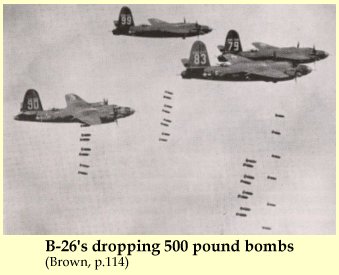
 |
Journal Entries:January – Easter, 1944 |
Yesterday on the last day of the year I completed my twenty-second raid. It was a milk run.

I was riding with Lt. Felt of Nebraska. Our target was another no ball constructional [2] near the village of Ardres, France. We were carrying six five-hundred pound bombs.
The trip was without incident. The weather was bad here over the island but it cleared over the target area. We made a long bomb run, unloaded, and missed the target, the bombs landing in an open field. Three of my bombs stuck in the racks and I was forced to salvo half of my load. We were dropping on the leader so as to get a good pattern and we did get a beautiful coverage on the open field.
We returned through a thick haze. On seeing flak bursts in the air above the English coast at Clacton we fired the colors of the day and swept across the coast.
We had a party last night to ring the old year out and the new one in. Thus 1943 ended and the new year was greeted with a hope and a prayer that it would mark the end of the war.
January 2
...any man's death diminishes me, because I am involved in mankinde. And therefore never send to know for whom the bell tolls: it tolls for thee.
John Donne
"The Tolling Bell"
January 4
After a pre-dawn take off this morning I was on my twenty-third mission. It was another no ball near the small village of Fruges, France. We missed our landfall at the French coast coming in at Berks-sur-Mer instead of Le Touquet. The lead ship altered course and we flew up the coast to our landfall
 and swept on in, and made three pas
and swept on in, and made three pas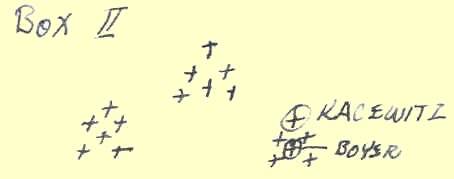 ses at the target before we finally dropped.
ses at the target before we finally dropped.
I was with Chuck Boyer who was leading B-Flight today.
I received a letter from Lard today written on the 28th of December. He is at last in England. I answered him and I hope to see him soon.
February 1
"A man never dies until his work is done."
Homer Lea
February 16
Yesterday on a rare beautiful English day I ran my first mission with the 391st Bombardment Group and if the mission
 counted, it will make twenty-nine for me. How I came to be with the 391st will take some telling.
counted, it will make twenty-nine for me. How I came to be with the 391st will take some telling.
The 391st is a new Group, just arrived fresh from O.T.U. in the States. It is a well trained outfit but lacking in men of combat experience. It was the idea of higher headquarters to insert into this new group that that it needed most. It was also the desire of
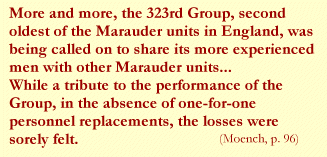 higher-ups to have this new outfit on operations in ten days. (We made it in fourteen.) In order to do this Wing left it up to the four old Marauder Groups to choose eight complete crews and send them to the new outfit to help get things started. How Chuck Enderton, my pilot, was sucked in I'll never know but anyway we were packed and transferred on a twelve hour notice and now we are here and operating.
higher-ups to have this new outfit on operations in ten days. (We made it in fourteen.) In order to do this Wing left it up to the four old Marauder Groups to choose eight complete crews and send them to the new outfit to help get things started. How Chuck Enderton, my pilot, was sucked in I'll never know but anyway we were packed and transferred on a twelve hour notice and now we are here and operating.
Our first briefing was a dry run and a horrible mess of confusion. Our second was none the less horrible and to top it off the bombs weren't loaded when we arrived at ships. After two delays we took off. We were flying number four under our new Colonel (Williams) and we were deputy box leaders. We were briefed for Beaumont Le Roger airdrome in France near Rouen. We turned back before we made landfall but flak was reported near the enemy coast so we believe it counted as a mission. (the mission ended up not counting; see below)
In the Colonel's plane was Lt. Erickson (Navigator) who was one of my underclassmen at Ellington pre-flight.
It was a loss to leave Mick and Partridge and the other boys that I had learned to like.
This new outfit is new, very new, and it lacks that smooth running that comes from time over enemy territory and time in the briefing room. I hope it settles down soon and I think it will.
I was to have met Lard on the ninth in London but I was in the act of moving and couldn't get off. I received a letter from him yesterday saying that he would be in London on the 14th and 15th. We'll have to arrange another meeting. I intend to go to his
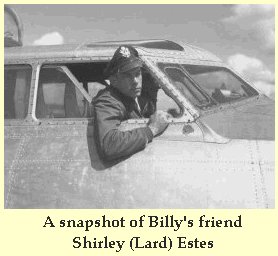 base on my next day off.
base on my next day off.
I also received a sweet Valentine from June. What a gal. Sometimes I could kick myself for leaving the states without telling her how I felt. But then other times like the time when I saw White, Hook, and Echol go down in flames [3] I think maybe I was right in not telling her anything. I won't tell her on paper what I didn't have nerve enough to tell her in person. If anything should happen to me it would be better if she didn't know...
In my list of missions I have jumped from 23 to 29. I will take up the missing raids in another entry. I must journey to Earls Colne and visit my old outfit and get some information concerning these particular raids from "Chuck" Boyer. Boyer took over Chuck Enderton's flight when we left. Ole "B" flight of the 455th.
Lard is operational now and I believe his first mission was Frankfurt .
February 17, Friday
That's probably the worst part of war, its boredom and frustration.
Lt. Col. Frank Kurtz
"Queens Die Proudly"
February 29
To take up the missions 24-29 and those following:
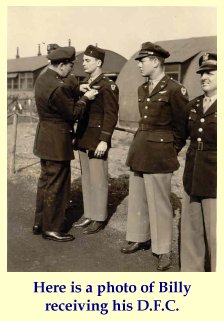 To start with number 24 which I was on January 7, '44. I was with Enderton and McAdam. We were leading the high squadron of Col. Woods' (C.O. 323rd) lead box of eighteen. It was an easy mission and we didn't get to drop our bombs because of clouds in the Cherbourg area. Our target was a no ball in that region.
To start with number 24 which I was on January 7, '44. I was with Enderton and McAdam. We were leading the high squadron of Col. Woods' (C.O. 323rd) lead box of eighteen. It was an easy mission and we didn't get to drop our bombs because of clouds in the Cherbourg area. Our target was a no ball in that region.
My D.F.C. mission [4] was a no ball in the Pas De Calais area. It was near the village of Ardre, France. It was on this mission that I saw my first enemy fighter at close range. We were on our bomb run when an M.E. 210 came for our formation from over Graveline. I believe the German just stumbled into our formation because I watched him all the way calling out his position to our gunners and I didn't see him fire a shot. The most amazing thing though was the fact that he came within fifty yards of our formation and not one of our gunners fired on him because he came so close they thought he was in a mosquitoe. We were leading low squadron first box of eighteen led by Major Wilcox. We missed our target that day. I was with Chuck and Echo was bombing.
Mission 26 was a no ball in the Pas De Calais area near Hesdin. No incidents of interest and can't remember whether we dropped our bombs or not.
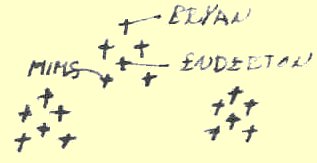 Mission twenty-seven was a horrible experience. We, Chuck, McAdam and I were deputy box leaders under "Jamey Boy" Bryan, Capt. from Utah.
Mission twenty-seven was a horrible experience. We, Chuck, McAdam and I were deputy box leaders under "Jamey Boy" Bryan, Capt. from Utah.
March 16, Molesworth
Our target was again a noball, this time near St. Omer, France. We crossed the French coast on top of about four to eight tenths cloud cover and sailed on inland to a turning point which was to be at Frévant, a rather large village some twenty-five miles south of St. Omer. We expected an intense concentration of flak at or near the target and the flak we received over Frévent came as a shock. The three-twenty-third had a formation of seventy-two ships in the air that day and Jamey Boy was leading number two and it so happened that as we turned at Frévent number two box was between numbers one and three.
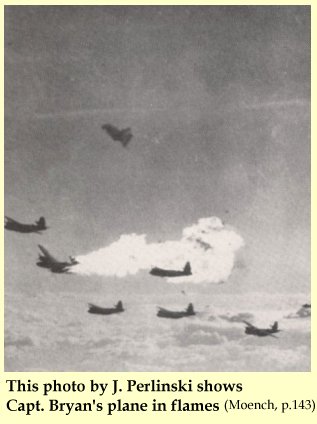 The flak that Jerry threw at us was the most accurately directed flak I have ever seen. The first bursts were in our formation at exactly our altitude. Bryan immediately turned left but number one box was over there; he swept back right: our turret gunner reported our left wing man (R.P. Mims) going down and no sooner had the words died on the inter phone when there was a blinding red flash ahead of us. Chuck and I could feel the terrific heat through the wind shield. The turret gunner (Ehalt) felt the heat on the back of his neck and thought we were on fire. Bryan had received a direct hit in one of his main fuel tanks and his plane burst into flames. His ship dropped straight down in a flaming ball, missing ours only by a few feet. At first we didn't realize what had happened and then it dawned on us that we were now in
The flak that Jerry threw at us was the most accurately directed flak I have ever seen. The first bursts were in our formation at exactly our altitude. Bryan immediately turned left but number one box was over there; he swept back right: our turret gunner reported our left wing man (R.P. Mims) going down and no sooner had the words died on the inter phone when there was a blinding red flash ahead of us. Chuck and I could feel the terrific heat through the wind shield. The turret gunner (Ehalt) felt the heat on the back of his neck and thought we were on fire. Bryan had received a direct hit in one of his main fuel tanks and his plane burst into flames. His ship dropped straight down in a flaming ball, missing ours only by a few feet. At first we didn't realize what had happened and then it dawned on us that we were now in
 the lead of box two but the flak had split our box of eighteen up and we had only our right wing man with us. We tacked on to number one box and the whole group bombed a secondary target on the coast near Le Tourquet. Three-twenty-third lost three planes that day over Frévent in the space of 60 seconds.
the lead of box two but the flak had split our box of eighteen up and we had only our right wing man with us. We tacked on to number one box and the whole group bombed a secondary target on the coast near Le Tourquet. Three-twenty-third lost three planes that day over Frévent in the space of 60 seconds.
Mims' and Bryan's crew were the closest to us of course being in the four-fifty-fifth squadron. Mims and his co-pilot Jackson were barrack mates of mine and I had spent many passes with both of them in London.
With Bryan were Capt. "Chuck" Whyte (Squadron Navigator), 1st Lt. Willie Hook (Navigator on Bryan 's crew) and "Salvo" Echo who was the bombardier the day I flew my twenty-fifth mission. I remember talking to these last three men just before take off that day. We were all tired and were wishing that the mission would be scrubbed. All of the above took place on Feb. 5th, '44. [5]
On the 6th of Feb. we made what may have been our last raid for the 323rd and we were leading eighteen this time to rendezvous with the three twenty-second and hit a no-ball in the Dieppe forrest area. The box with the exception of one flight of three was made up of four-fifty-fifth crews.
 We made rendezvous with the other group and proceeded to our target. At the I.P. we found that clouds had covered our target and our GEE was out. The other group was flying a heading that appeared to be a GEE line. We made a quick decision to follow them and we bombed on them. The target was smashed. On the return home we were forced, due to bad weather, to divert to a Field near Norwich named Hovsham St. Faith. We brought our eighteen in safely.
We made rendezvous with the other group and proceeded to our target. At the I.P. we found that clouds had covered our target and our GEE was out. The other group was flying a heading that appeared to be a GEE line. We made a quick decision to follow them and we bombed on them. The target was smashed. On the return home we were forced, due to bad weather, to divert to a Field near Norwich named Hovsham St. Faith. We brought our eighteen in safely.
This completes the history of raids through twenty-nine.
I'm writing at Molesworth, a B-17 base north-west of Cambridge. It is where Lard is stationed and I'm just paying him a visit while I'm on seven day leave. He is out today on U.S. business.
To continue with my writeup of raids.
On Feb. 22 we flew an abortive mission to Conches Airdrome, France. Mac and I were leading with Colonel Williams' 391st. As far as I know now the mission did not count but because of the situation it produced I feel it is worth telling. We had to climb through an overcast and during the climb we were separated from our second box led by Capt. Rutledge and the 1st Lt., now Capt. Penner (Former Hondo classmate of mine) Navigator. There were no breaks in the undercast once we turned on course for fighter rendezvous and we had no GEE box. I did plain dead reckoning to Beachy Head (Fighter Rendezvous point). There we met Rutledge and his eighteen and picked up our fighters, but we still couldn't see the ground to find just exactly where we were. So I did D.R. across the channel and when my E.T.A. for the point at sea from which we were to turn into enemy territory was up I advised the Colonel to turn around. We had been over a solid overcast for nearly an hour and I didn't want to take a chance and take thirty-six ships into France when I wasn't sure of landfall position. Chuck was with us and he backed me up and we turned around.
All of this created quite an uproar when we landed. Col. Lewis, Wing C.O. was there and he had a talk with me and Col.
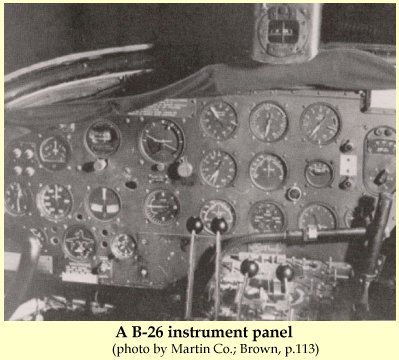 Williams. I never dreamed when I told the Colonel to turn around that it would create such an argument. The wing Navigator (Capt. Ohmstead whom I knew at Avon Park) said the next day that I should have gone in.
Williams. I never dreamed when I told the Colonel to turn around that it would create such an argument. The wing Navigator (Capt. Ohmstead whom I knew at Avon Park) said the next day that I should have gone in.
Someone once said that there are times when a man must use his own judgment be it right or wrong and that is what I did that day. If the same circumstances were ever to occur again and I was not ordered by higher authority to do otherwise I would do just as I did before.
Two days later I had a chance to lead the 391st again with Colonel Williams as pilot and Mac as Bombardier. Chuck went as co-pilot. This was Feb. 24 and our target was Gilje Rijen airdrome in Holland. It was the first time this new group ever crossed enemy territory.
We couldn't have asked for a more beautiful day. I picked up my landfall point twenty-five miles out at sea. We swept in over Holland with R.A.F. eleven Group providing excellent fighter cover.
Mac hit his aiming point and the mission was a success. It was number thirty for me.
The next day, Feb. 25, marked another exciting episode in combat for me. I was riding with Kahley, Capt. 574th Sqdn. We were leading high Squadron lead box in a thirty-six ship formation that was supposed to bomb Cambrai airdrome, France.
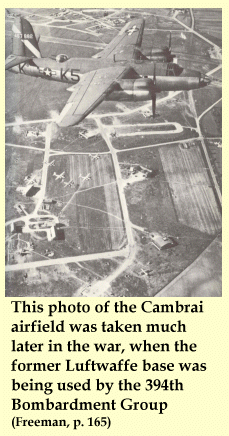 We had to climb through an overcast in southern England but managed to make fighter rendezvous O.K. at a point in the Channel just off Cayeaux, France which was to be our landfall in.
We had to climb through an overcast in southern England but managed to make fighter rendezvous O.K. at a point in the Channel just off Cayeaux, France which was to be our landfall in.
Colonel Brandon, 575th C.O., was leading with his Squadron Navigator doing the navigation. After we picked up our fighters he turned south and entered the coast at Le Treport some ten miles south of proposed landfall. Instead of turning to the northeast after landfall in order to pick up the I.P. he continued on the same course.
From that point on he and his Navigator were lost and we began a tour of France I'll never forget.
We tried to call the Col. and tell him; the Spits tried to turn him around. We were just a few miles north of the Seine River when Kahley decided to leave the formation and take his six ships home. The Spits stayed with us and we returned to base safely.
That same day, Feb. 25, I ran number 32. It was a no ball near Fruges, France. I was leading eighteen with the Colonel. We missed bomber rendezvous after climbing through an overcast and followed the 322nd instead of the 387th. We went in over about nine-tenths cloud cover and didn't find the target. No incidents.
Number 33 was on Feb. 28. It was led by Capt. LeFramboise and our target was Rosiéres Airdrome, France. Except for a barrage of flak at Montdidier (I.P.) which spread our boxes and threw the lead box off course a little, we had no incident take place. I remember being very tense on this mission. I blamed it on not enough time off and I think I was right.
On Feb. 29 Major Miller, 572nd C.O. led us on a no ball raid in Pas de Calais area. It was no. 34 [6] for me. Too many clouds; we didn't drop.
On March 4 I ran number thirty-five. We were to attack railroad yards at Malines, Belgium. The weather was very bad and all of bomber command who had this target were recalled. Our recall came up just after we crossed enemy territory. We did a 180º turn and came out. We were over ten tenths but Jerry threw up plenty of flak from Dunkirk. As we passed out over the Channel I saw more B-26's at one time than I've ever seen before. Group after group with their Spit escorts were coming and going all amid jet black bursts of heavy flak; it was a sight to remember even though it was terrifying in a way.
The next day we were supposed to hit a noball near Lambres, France. We made three passes but visibility was so bad we had to give up and come home. I rode that day with Capt. Sterngold on a wing, Number 36.
On March the 6th Chuck's ship went out and I sandbagged along with Lt. Morris. We rode wing and I was glad when we got started that I had gone along. Our target was the yards at Hirson, France. It was a deep penetration and it was a beautiful day in France. We followed the 323rd in and it was good to see their white tails again. We hit our target and returned without loss. [7]
This brings me to a sad incident that happened that night, March 6th. Col. Samuels, air executive of 391st read us a directive from Ninth Bomber Command stating that there was no limited tour for Marauder crews effective immediately. All of which meant we were in England till victory was won. It still stands that way as I'm writing now.
Anyway on the 7th of March I was on #38. I rode with Chuck and we led second box. We followed the 322nd into Criel Railroad Yards near Paris and failed to bomb because of cloud cover.
I saw the Eiffel Tower before we passed over the clouds and the famous city of Paris seemed to sleep beneath a blanket of clouds..
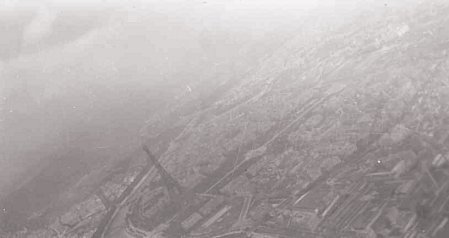 |
We do not know when Billy took this picture of the Eiffel Tower, and it was probably after his outfit moved to France later in the year; but it could have been on this mission... |
April 9–Easter in E.T.O.
I was visiting with McKenna the other day at Earls Colne. He is a checked out pilot now. That is something he has been waiting and working for for some time now. I remember when we were in Florida how he wished so much to be a first pilot and how he turned down a chance to be one just before we left the states because he wanted to remain with the crew. I remember too how he could have checked out and at least proved to himself that he could fly a Marauder. Partridge never gave him that chance. Now he is at last a first pilot. I flew with him on a cross country over England. We flew up to Kings Lynne then over to Cambridge and around East Anglia. He did a good job of leading a three ship formation. True, he may not ever be as good a pilot as Partridge but he has something that Peter [8] lacks and that is devotion to duty. I like Partridge, I like him very much in fact and I would fly to Hell with him, but McKenna is a man, Peter is still a boy.
 On this Easter morning I attended chapel service here on the base. I had wanted to go to London and attend services in Hyde Park or St. Pauls but after I heard Chaplain Comfort's message I was so glad that I remained on the Post.
On this Easter morning I attended chapel service here on the base. I had wanted to go to London and attend services in Hyde Park or St. Pauls but after I heard Chaplain Comfort's message I was so glad that I remained on the Post.
"The things which are not seen are eternal"; this was the text to an inspiring message.
I believe things are looking up for us (the allies) all over the world. I feel with all my heart that the Germans will be forced to give up the fight by mid-July. I pray that not too much blood be spilt by then.
In my next entry I intend to finish my story of my first Atlantic crossing—Meeks Field to Preswick Scotland. [9]
Display index of mission maps in a new window
[1] As people often do at the beginning of a new year, Billy mistakenly wrote the old year here in the Journal.
[2] Although this might look like a misspelling of "construction," I have come across the term "constructional" in referring to the NoBall targets. For more information on these important targets, see this page.
[3] Billy is referring here to Whyte, Hook and Echo, men lost on February 5, 1944, according to Moench, p. 142. Billy had not actually described this mission yet but does so below.
[4] Click here to see what a DFC looks like, and to read the citation that came with Billy's
[5] As it turned out, Mims and some of his crew survived the "horrible experience" of this mission. Click here to learn more about this story.
[6] Billy mistakenly wrote "33" here again, an obvious error.
[7] On the B26.com website, I found the following unit citation, from "COMBOMCOM NINE," referring to this mission:
[8] I was initally very confused by this reference to "Peter," and figuring it out took bit of research and cogitation. The "Partridge" Billy is discussing earlier in the paragraph is certainly Frederick R. Partridge, the pilot on Billy's Atlantic crossing flight in July of 1943, a flight on which "Mick" McKenna was the co-pilot. (These two men, Mick and Partridge, are also shown as being in the same crew in England in a picture loaned by Mrs. McKenna, that you can see on this page with information about their plane, the "Jolly Roger.") Partridge's name appears on the orders sending himself, Billy and Mick overseas so I am sure it is correct. He was referred to as "Ray" in a 1943 letter to June, a nickname that fits with the middle initial given on the orders, but he must have also had the nickname "Peter Piper." A photograph I am confident is of Partridge with his plane (also on the "Jolly Roger" page) has "Peter Piper," underlined and in Billy's handwriting, on the reverse.
Ray Partridge was killed while serving as a pilot in Korea in 1952. For more information about him, received from his sister, click here.
[9] Sadly, Billy never did complete the story of this crossing.